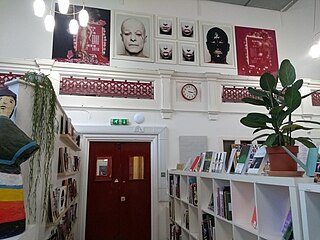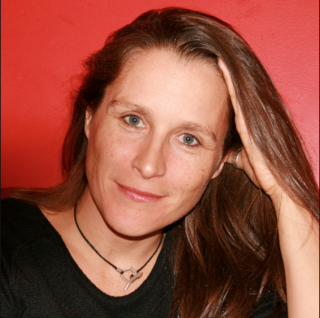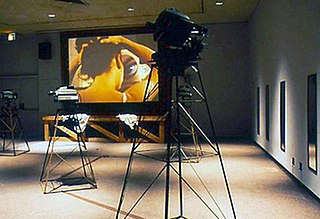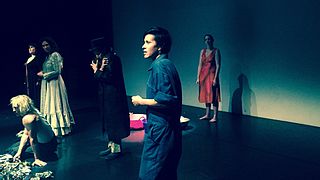
Vaginal Davis is an American performing artist, painter, independent curator, composer, filmmaker and writer. Born intersex and raised in South Central, Los Angeles, Davis gained notoriety in New York during the 1980s, where she inspired the Bushwick neighborhood of Brooklyn's prevalent drag scene as a genderqueer artist. She currently resides in Berlin, Germany.

Catherine Sue Opie is an American fine-art photographer and educator. She lives and works in Los Angeles, as a professor of photography at University of California at Los Angeles.

Hustler White is a 1996 film by Bruce LaBruce and Rick Castro, a satirical black sex comedy about gay hustlers and their customers on Santa Monica Boulevard in West Hollywood, California. It stars Tony Ward and LaBruce in an addition to the Queer Cinema canon, which is also an homage to classic Hollywood cinema. Also appearing in the film are Vaginal Davis, Glen Meadmore and Graham David Smith.
Amelia Jones, originally from Durham, North Carolina, is an American art historian, art theorist, art critic, author, professor and curator. Her research specialisms include feminist art, body art, performance art, video art, identity politics, and New York Dada. Jones's earliest work established her as a feminist scholar and curator, including through a pioneering exhibition and publication concerning the art of Judy Chicago; later, she broadened her focus on other social activist topics including race, class and identity politics. Jones has contributed significantly to the study of art and performance as a teacher, researcher, and activist.
SUPERM is an international multimedia art team founded in 2004 by Russian author and artist Slava Mogutin and American artist and musician Brian Kenny. The artists come from different backgrounds: Siberian-born Mogutin was exiled from Russia at the age of 21 for his queer writings and activism; Kenny was born on the American military base in Heidelberg, Germany, and grew up traveling throughout the US with his Catholic, military family. They are responsible for site-specific, multimedia gallery and museum shows in New York City, Los Angeles, London, Berlin, Stockholm, Oslo, Bergen, Moscow, and León (Spain).

Ernesto Tomasini is an Italian actor/singer/writer living in Britain. Best known for his more recent forays into contemporary music, he has also had a 35-year career on the stage.
Puzzy Power is a Danish film company started in 1997 as a subsidiary to Lars von Trier's company Zentropa, with the goal of producing hardcore pornographic films for women. It is the only time ever a mainstream film company has openly produced hardcore pornographic films.
Susan Matheson is a costume designer who designed costumes for the films The Kingdom, Friday Night Lights, Blue Crush, Crazy/Beautiful,Honey, Panic and Best Laid Plans. She has designed for three movies starring Will Ferrell - Step Brothers, Semi-Pro, and Talladega Nights: The Ballad of Ricky Bobby. She designed for the film Couples Retreat starring Vince Vaughn and Jon Favreau which premiered in the fall of 2009.
Juliana Snapper is an opera singer, voice researcher and artist. She received her B.M. in vocal performance from the Oberlin Conservatory where she studied under Richard Miller, and her M.A. in critical musicology at University of California, San Diego.
Lee Adams is a London based performance artist, curator and experimental film maker. Much of his work has been influenced by the ideas of French dissident surrealist and philosopher Georges Bataille.

Alex Binnie is a tattooist, and printmaker; he has been a musician and performance artist.

Live Art Development Agency, known by its acronym LADA, is an arts organisation and registered charity founded in London in 1999 by Lois Keidan and Catherine Ugwu. LADA provides professional advice for artists as well as producing events and publications intended to enhance the understanding of and access to Live Art. They are an Arts Council England's National Portfolio Organisations. In 2021 Lois Keidan stood down as director, and Barak adé Soleil and Chinasa Vivian Ezugha were appointed as joint co-directors.

Catherine Gund is an American producer, director, and writer who founded Aubin Pictures in 1996.

Dorit Cypis is a Canadian-American artist, mediator and educator based in Los Angeles. Her work has collectively explored themes of identity, history and social relations through installation art, photography, performance and social practice. After graduating from California Institute for the Arts (CalArts), she attracted attention in the 1980s and 1990s for her investigations of the female body, presented in immersive installation-performances at the Whitney Museum, International Center of Photography, San Francisco Museum of Modern Art (SFMOMA), and Musée d'art contemporain de Montréal. Counter to much feminist work of the time, Cypis focused on interiority and personal mythologies rather than exterior political realms, and according to art historian Elizabeth Armstrong, made a significant contribution to discourse about the representation of women and female sexuality.
Human Resources Los Angeles (HRLA) is a non-profit exhibition and performance space located in Los Angeles's Chinatown dedicated to supporting interdisciplinary, performative and experimental art practices.
Julie Tolentino is a visual and performance artist, dancer, and choreographer. Her work is influenced from an array of visual, archival, and movement strategies.
Sheree Rose is an American photographer and performance artist. She is best known for her collaborative work with performance artist Bob Flanagan, and her photography documenting a wide range of Los Angeles subcultures, especially in relation to BDSM and body modification.

The Highways Performance Space is a performance venue in Santa Monica, California, which focuses on new works and alternative pieces. The organization is a space for LGBTQ artists to experiment with form and content. Performed work includes theatre, music, dance, spoken word, interactive media, and visual arts.

Jeanelle Mastema is a Mexican American experimental body and performance artist from Boyle Heights, California. Mastema incorporates ritual into her work through play piercing, hook suspensions, live magick and sacred objects. She performs internationally, solo and in groups, often acting as a medium for group intentions or a symbolic altar for channeling energy. Through performance, Mastema enters into a meditative head space to disconnect from mundane consciousness. Her major influences include: Butoh, Kenneth Anger, Surrealism, Psychedelic Art, the Viena Actionists, Kembra Pfaher, Leonora Carrington and Alejandro Jodorowsky. She also works as the West Coast sales manager for an adult novelty toy store. She also worked at the Pleasure Chest for many years and is featured in a film called, Thank You Come Again, based on working there.
Catherine Oliaku Ugwu is a British executive producer, artistic director, and consultant working in large-scale ceremonies and events, including for the Summer and Winter Olympics, the Summer Paralympics, the Asian, European, Islamic Solidarity, and Commonwealth Games, and the Millennium Dome.










